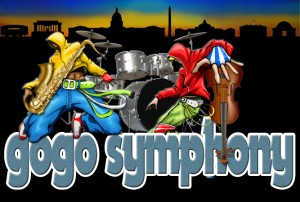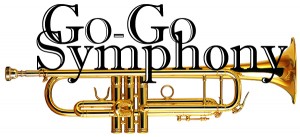It’s time for me to plan a marketing strategy for the go-go symphony, my composition that plays symphonic music over Washington DC’s unique go-go dance beat. I figure that blogging about my thought process would help me think, so here we go.
But first some basic information for the uninitiated: As I explained in more detail in my last blog post, go-go is a sub genre of funk that has been extremely popular in the Washington DC area since the 1970s, especially with African Americans. Its main feature is live swinging polyrhythm — endless amounts of it — with drums, congas, cowbells, timbales, rototoms, and tambourines. It also uses improvisation and audience call and response. The beat never stops during a show; one song just morphs into the next. The locally recognized beat alone drives fans crazy, so I decided that composing music for an orchestra using it as raw material would make for an exciting show.
My first decision is to start my own ensemble. The reasons relate to musicality and promotion:
Go-go music is polyrhythmic, so it requires several percussionists. If an orchestra had to hire extra percussionists for my piece, that would be an added cost, and might be one reason they’d hesitate to do it. On top of that, I insist that we perform the go-go symphony with genuine go-go percussionists, who have a particular style and feel that cannot be communicated by music notation alone. That would definitely be an extra cost for an orchestra. And there’s another problem. The go-go percussionists might not be members of the musicians union, which they’d have to be to play with the orchestra.
With regards to promotion: In the pop world, repetition of material is key. Pop bands play the same sets over and over again, slowly rotating new material in and out, to build their audiences. I get the impression that traditional symphony orchestras might repeat the standards of Beethoven, Mozart, etc., but they won’t necessarily repeat a performance of the go-go symphony. New music ensembles offer more possibility because they seem to aim for world premieres of new pieces. But then they drop those pieces for new world premieres, which offers pop audiences nothing familiar to hang on to.
Therefore, I think the best thing to do is to form my own ensemble. That way I can produce repeat performances that audiences can follow, and I can freely employ authentic go-go percussionists. I could have a barebones ensemble for parks and clubs, and this ensemble can then attach itself to larger orchestras when invited for the full effect. As time goes on, I can slowly grow the ensemble’s membership as needed.
Another marketing strategy I have is to hire go-go music entrepreneurs whenever possible. After all, community relations are key to a marketing campaign. There are go-go musicians, t-shirt designers, sound technicians, photographers, studio owners — you name it — that I can hire. In fact, I just hired website designer Kato Hammond, founder and creator of the “Take Me Out to the Go-Go” website. As a result of that connection, he interviewed me and wrote an article about the go-go symphony in his website, the central news portal of the go-go community.
In the article, I tailor my interview to the website’s go-go audience, ending it with, “I hope we can have all kinds of people partying together to the go-go beat. I’d like to break down musical and social barriers. I want people to give go-go the respect that it deserves.” The go-go community, like the classical world, wants more people to know about its music; as past attempts to bring go-go to a mainstream audience have failed. When I blog here on Greg’s website, I talk about spreading interest in classical music. I always try to be aware of my audience when communicating via the media.
Along the same lines, artwork is a big consideration. I learned in the past that the average person will spend only fifteen seconds trying to figure out what a website is about before moving on or staying to explore. Artwork, like music, speaks a thousand words, so I’m being picky about how it looks. I told Kato to design the artwork and logo so that it communicates “party with a funky orchestra over the go-go beat.”
This is what he came up with as poster or webpage art:
Here is the basic logo:
These works are what I selected, based on an attempt to counter classical music’s current image. Kato’s first instinct was to honor the tuxedo wearing formality of classical music with this logo:
I’m a little torn, because the go-go audience seems to like the idea of a tuxedo wearing formal orchestra, as I described in my last blog post. Kato’s first instinct reminded me of that. But our target audience is not just the go-go community, and I think what I selected creates more intrigue and curiosity for everyone else. This artwork may still be a work in progress. Should we create a logo that combines both urban and formal? I wouldn’t mind some feedback on this artwork from readers of this blog.
Our website also includes a sign up link for a newsletter to help build our audience. Anytime we perform for or otherwise interact with people, we will collect email addresses for the newsletter. I put the sign up link on the upper right hand section of the website, where many people tend to look. That is how important a sign up link is.
These are just the big ideas. I need a more detailed step by step plan. How do I go from collecting emails in parks and clubs to touring and playing with larger orchestras? My brain is still storming. I will cover more of my thoughts in another post.




Great article, and great ideas. I will look forward to hearing, and seeing, and experiencing, the Go Go Symphony. As a “classical” artist (opera) I fear for the future of classical music, and perhaps you’re on to something. GO FOR IT !!!
Thanks, Jonathan!
I signed up for your newsletter. I have been waiting for something like this, as you can see in this post: http://dmvclassical.wordpress.com/2009/12/16/go-go-handel-who-did-you-call-go-go-handel-whats-his-name/ I’d love to attend and review the formal premiere – I’m pretty certain I know more about go-go than any of the other classical critics in the DMV!
Hi Andrew! Thanks for your interest. I remember an article in the Post (or something) long ago about classical music’s struggles for audiences. Someone posted an comment suggesting we mix go-go with classical orchestras. Was that you? Also, were you the one that reviewed NSO’s performance with Chuck Brown?http://dmvclassical.wordpress.com/2011/09/05/representing-where-youre-from-national-symphony-orchestra-and-chuck-brown/
You’re review of the orchestra was spot on. I will only let genuine go-go percussionists play the beat, partly because of what I heard from the NSO.
I’m excited to meet you! We are definitely birds of the same feather!